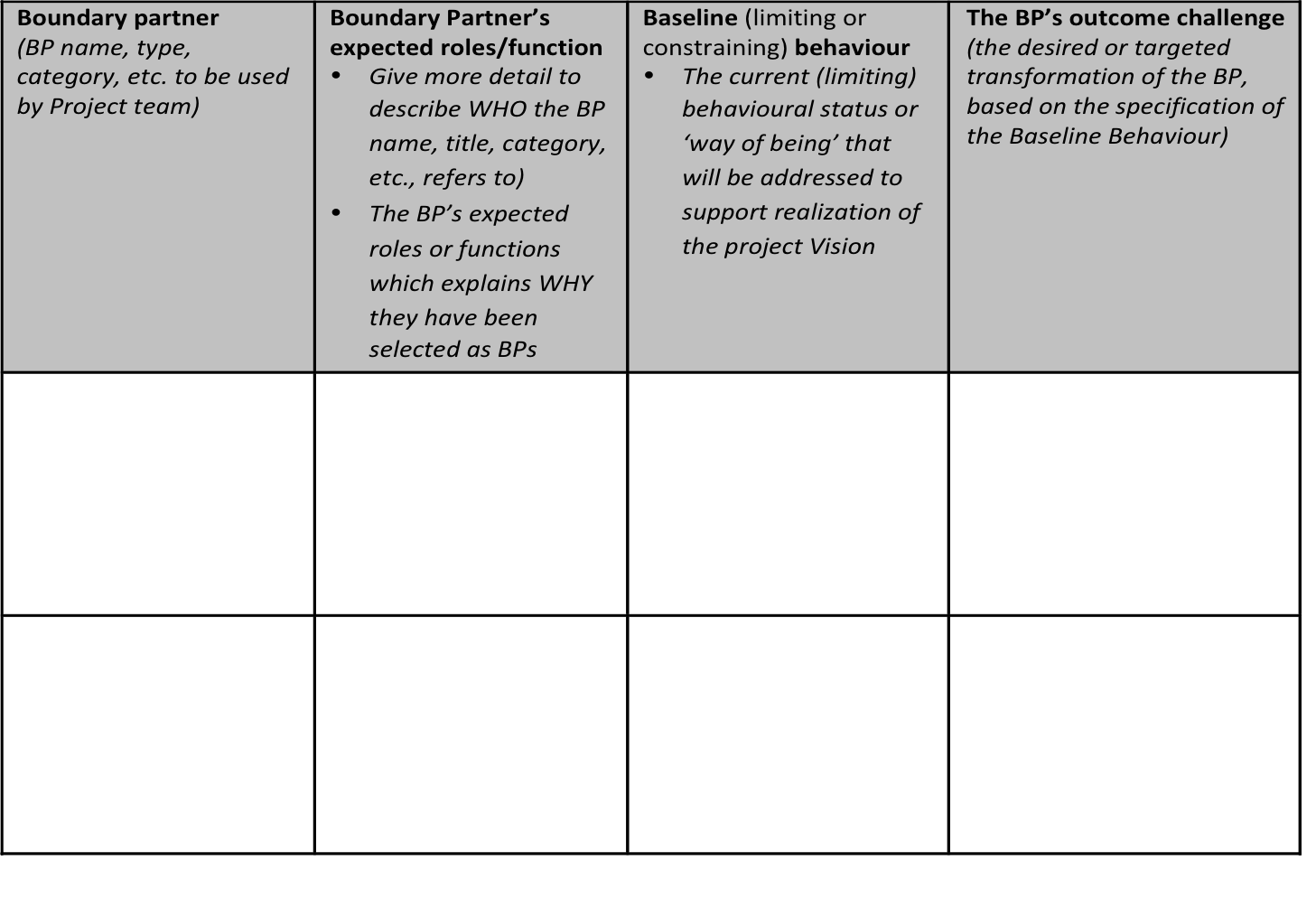Outcome Mapping Practitioner Guide
Characterising Boundary Partners
The identification of the Boundary partner (BP), the BP’s outcome Challenge and Progress markers begins with a clear identification of the BP and the prevailing (baseline) behaviour that the project seeks to address.
Author: Julius Nyangaga
Published: Friday 12 September 2014
Creating a baseline in Outcome Mapping from Outcome Mapping on Vimeo.
Introduction
The value of Outcome Mapping is an outcome-oriented lens which emphasizes the fact that whatever goal a project seeks it will be implemented or demonstrated through behavioural change. The project then strives to support that actor so that they can to do what they should do to achieve desired goals.
Outcomes are not just about numbers, e.g. increase in yields, reduced mortality rates, fewer incidents of gender violence, but what it takes to achieve those numbers. The cultural and institutional ‘ways of being’ that lead to those numbers are the outcomes projects try and support. But whose behaviour should the project then target?
What stakeholder does the project team work with to deliver this change? In the OM manual a boundary partner is defined or described as entities “with whom the program interacts directly and with whom the program can anticipate opportunities for influence”. But there is not clear guideline in how to identify boundary partners; project teams are supposed to select from the list of actors (or stakeholders) related to the project vision and mission.
The identification of a Boundary Partner and an analysis of the BPs baseline behaviour is a step that has been found significantly useful when developing target (desired) behaviour (the outcome challenges) and progress markers. The trick is to know how to selected stakeholders from the project’s sphere of influence, given that BP’s are meant to exert affect change beyond the project’s sphere of influence while it is demonstration transformation in them that enables a project team learn from project progress and performance.
Identifying the Boundary Partners
When developing a Project’s Intentional Design, a stakeholder listing and analysis is usually done to help identify the few (5 – 8) Boundary Partners the project will work with to achieve the project vision. The first challenge is selecting the BPs because a brainstormed list is a diverse range of individuals, population groups, organizations and institutions (or institutional departments). If change is going to be based on behavioural transformation (the outcomes to be supported), it is important then to have in mind a particular stakeholder entity. The name or title of the BP can refer to a wide range of other related actors but who all have the potential of being very different from what the BP name indicates. For example ‘farmers’ may mean the farmer population of individuals (or households), farmers as a group or cooperative, farmers as represented by the group’s or cooperative committee. Or the Ministry of Agriculture can be referring to the Minister, the technical policy level director, the district or country level bureaucrat, or the field-farmer level extension staff.
Teams use one name to refer to a type of BP, so once a name is used it is important to be clear as to who exactly who the project has in mind. It is therefore important to develop, maintain and update a feature about the project’s selected Boundary Partners, i.e. who they are, and their CURRENT roles and functions.
Developing the Outcome Challenge from the baseline behaviour
Once the few 5 – 8 BPs have been selected, the team is expected to develop an Outcome Challenge and later on the Progress Markers. The Outcome Challenge, which is the desired (vision-level) behaviour of a BP can be very wide, and it is useful to have a narrower focus. A baseline analysis helps highlight what form of behavioural transformation the BP is short on, in relation to the project vision. Analysing and describing this baseline limitation helps team then indicate the type of change to be targeted as an Outcome Challenge or gradual transformation that will signify progression towards that Outcome Challenge.
That way, it is easy to show the exact status or limitation as a baseline from which the project is working from to the Outcome Challenge.
In an intentional design or review forum, the information should be developed using the following table/

The added value of using this piece of OM;
- The innovation helps team in being clear about who they mean by a particular name or title of a BP and the reasons why a particular Outcome Challenge (or even set of progress markers) are identified.
Challenges of using this piece of OM;
- Given the interest in using a singly name or title of a BP, agreeing on who exactly this should represent can take some debate and delay.
- Analysing a baseline ‘limiting’ behaviour in preparation for the next step(s) may not be easy, especially if the BP is taking part in the discussions. The BP will want to defend and/or justify their limitation leading to delay and possible discontent with the project team and project objectives.
Key take-home messages for someone else wanting to use this tip / trick / nugget.
- Implementing these steps requires excellent accommodative facilitations
This nugget was applied in: The Kilosa-Baganmoyo Livestock project, The North Tanzania Integrated Sustainable project and the Morogoro iWASH project
Related Practitioner Guide sections:
Associated resources:




